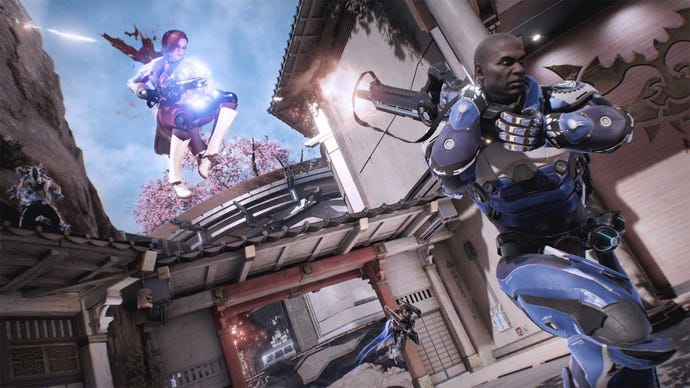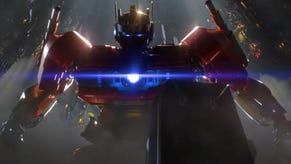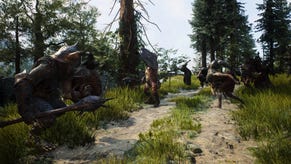Everyone is busy arguing how much LawBreakers is and isn’t like Overwatch, and I’m too busy having fun with it to care
LawBreakers is not Overwatch.
It seems you can’t release a class-based shooter with distinct heroes these days without it being compared to Overwatch. Nobody can deny Overwatch’s influence on the genre, but it’s a lot easier to see its effects on a game like Paladins than LawBreakers. So let’s get this out of the way first: LawBreakers is nothing like Overwatch.
It doesn’t clone its mechanics, focus, modes, aesthetics, or execution. The only thing the two have in common is that they both feature a colourful cast of characters. The same way a MOBA or - you know, Team Fortress 2 have had for years.
So what is it? LawBreakers is an arena shooter first and foremost. It’s unique in that its heroes aren’t balanced around set roles and different health pools, so much as they are around the different skills they require from the player.
In simple terms, all of LawBreaker’s nine heroes (eight in the beta) can damage and kill enemies with ease. The difference is that each of them requires mastery of movement and shooting mechanics unique to them. The heavier classes are just as vulnerable as the most agile if they don’t play to their strengths. The Assassin, the game’s grappling hook-wielding hero is near inescapable at close range, but the trick is that it’ll take you a while to master her controls enough to consistently hit players.
This is balanced out by her incredible speed, which makes her harder to hit when she’s moving, but a bit easier when she’s at the start of her swing. Even the Battle Medic, a role other games often equip with a healing beam and a meagre secondary, has a powerful grenade launcher and hover ability here - both exclusive to her - that allow her to lop grenades into a contested zone or shut down entry points.
Though some classes can be classified as support, there’s no equivalent of a Mercy or Symmetra here. Everyone has to get out and get kills or play the objective, everything else is secondary. If you really want to compare this approach with something, compare it with Quake Champions’. Even then, LawBreakers has the edge because it’s not trying to recreate an old success, and it’s not bound by decades-old rules and expectations.
LawBreaker’s main combat mechanic is a low-gravity zone found in every map. This area doesn’t change from match to match, and it's always placed somewhere crucial. Whether it be the middle zone in Turf War, or the Ball/Battery pickup in Blitzball and Overcharge, it's a location both teams will clash at, and it’s here that the game’s original design starts to shine. Movement now shifts from the ground, to the air, and onto higher up platforms specifically placed for low-G fights.
Your momentum will take you a long way here, but I can’t decide which class archetype navigates these zones best. The lighter, faster movers like Assassin and Wraith can get around very quickly, but their speed makes them harder to control. This can obviously be improved the more you practice, but it’s something that surprised me when I first played. On the other hand, the medium, and tankier heroes can just as easily down enemies while flying as they can on the ground thanks to their slower speed, which in turn makes them easier targets.
The best moments happen when fights alternate between in and out-of-zone skirmishes. Knowing your hero’s strengths and weaknesses is key in those moments, as you alternate between relying on their core abilities, and navigating the low-G zone. It’s like someone decided to put a trampoline in the middle of a football field. It doesn’t make sense at the start, but have a few firefights in these zones, and you’ll appreciate the value they add to the combat.
The way characters move also matters in LawBreakers. Every hero’s main movement ability (Shift by default) is vastly different from the rest. Some characters are inherently better in the air than they are on the ground, but everyone has a gauge they need to keep an eye on that’s consumed in different ways. The opposite is true for others who work best dealing splash damage to stationary and slow heroes. There’s an ultimate ability for all heroes, and they’re often fun and satisfying to use.
I’d like to think we’re witnessing a renaissance in skill-based shooters, and the return of skill-based movement is a large part of that. LawBreakers represents the apex of this. Games like Titanfall 2, and Quake Champions don’t quite have this depth to their movement mechanics.
As much diversity in mechanics the game's roster has, I didn’t see any particular team compositions emerge during my time with the beta. There’s no limit on how many could pick the same hero, so I can see this becoming an issue in public games as most people may just gravitate towards the most straightforward choices. Though I certainly did change my hero several times when the map and mode demanded it, the game’s intent on giving everyone the ability to hold their own in a fight balances this out. A good player will be an asset, even if they’re playing the “wrong” hero.
On the flipside, it makes abilities self-serving for the most part. This is true for the majority of heroes, save for the Battle Medic with her healing orbs and the Juggernaut with his deployable wall.
Unlike the completely original classes, LawBreaker’s game modes are variations of modes that exist in many other shooters. The game’s strength, however, comes from augmenting each one enough to turn it into something completely different, sometimes fixing age-old problems inherent in these ancient designs.
On the surface, Turf War looks a lot like Domination. There are three zones on each map that need to be captured, but the twist is that once a zone is captured, it gets locked until the end of the round, meaning the enemy can’t cap it. To make things more intense, you’re not earning a steady stream of points the longer and the more zones you hold. Instead, each capture represents a single point. After a few seconds, zones unlock and you get to do the same dance all over again.
This version of Domination works great in LawBreakers. It effectively focuses the fight on the remaining, unlocked zone without removing the intense rush that happens at the start of rounds. This setup also does away with instances of downtime in other games’ Domination that occur when you’re the only person capping the furthest point from your team’s spawn.
Brilliantly, comebacks can still happen in Turf War if you manage to claim all three zones in one round, earning your team three points.
Blitzball can easily be dismissed as a clone of Call of Duty’s Uplink, but it absolutely isn’t. In LawBreakers, the ball can only be scored when the player reaches the other team’s goal. You can’t throw it, and you can’t sit on it for too long or it’ll explode. The only way to score is to physically touch it down yourself. This creates a dynamic where heavier classes could stay in to cover the goal, as lighter classes and medics head out to grab it.
Other approaches are also viable, but the key thing here is that one player can make the difference so long as they could reach the goal. Finally, Overcharge is similar to Blitzball in that a Battery spawns in the middle, only you need to take it to your base and guard it until it charges. This takes time, during which the enemy team could still snatch it.
What makes this mode really fun is that the Battery keeps the charge, so someone could swoop in at the last minute and take it to their base. There’s always a 20-second delay between reaching 100% charge and scoring a point, but a last-minute grab is always exhilarating. This ingenious setup essentially makes the start of the match quieter compared to the pressure of those last few moments as the charge gets past 90%.
Uplink was too similar to Overcharge in my experience. There's also Occupy, which wasn't available in the beta.
There’s a running theme in all of the game’s modes: a clear focus on objective play without compromising gunplay. In all three, killing players won’t get you the win if your team isn’t playing the objective. You certainly can ignore objectives and just focus on kills, but you’ll still lose. All killing players does is buy you enough time to claim the objective until the enemy has respawned.
None of this would feel fun if the shooting wasn’t satisfying, or if movement was clunky. Thankfully, there’s none of that here, but LawBreakers doesn’t quite hit the mark in other, equally important parts of its design.
The personalities of all heroes are almost indistinguishable from one another. They’re all incredibly aggressive in their lines, and always trash talk the competition at every chance. This may not seem like a big deal, but when you’re being told different variations of ‘suck it’ every time you die, it gets old fast. Of course, in this case, it’s the game taking responsibility for deprecating you, not other players.
Heroes don’t admire their own kills or playstyles, and none of them are well-reasoned or zen, or anything other than 110% at all times. It’s like they’re constantly trying to get a rise out of you. This overly aggressive tone is represented in everything from the voice lines, animations, to the garish aesthetics and character skins. Even the scoreboard's design suffers from this. It took me a while to figure out which icon on the scoreboard represents kills and which represents deaths.
Both icons have the same frowny face – the game’s logo – but only one has the crosshairs icon overlay. Wouldn’t it have made more sense to keep the frowny face to the one tallying your deaths instead of using it on both?
It’s the game’s attitude that rubbed me the wrong way more than anything, and I feel it may do the same to others. It’s certainly consistent with itself, and I dare say that these small things likely reflect the nature of its designers. There’s nothing particularly bad about a character that’s in your face 100% of the time, but when all of them are this way it makes them less identifiable.
Everyone kept reminding me of Ruin, the Call of Duty: Black Ops 3 hero that only speaks to insult others. I got so tired of him in the beta, despite liking his ultimate ability, that it soured me on that whole game. Fortunately, I like LawBreakers more than I hate its grating, one-note heroes, but it ends up making an already highly-challenging, draining game less appealing than it should.
Ultimately, LawBreakers is a solid shooter with enough depth to last years. It’s adequately priced at $30, and more often than not succeeds in what it tries to do. The words 'arena shooter' get thrown around a lot these days, but if there’s ever a modern, original one of those, it’ll be this one.








